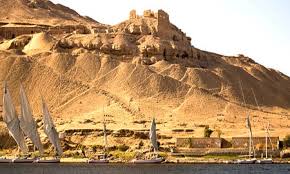
The City of Aswan lies on the east bank of the River while on the west bank, the desert almost touches the river interrupted some times by small villages and little spaces of cultivated areas. The biggest hill in front of the city, or (Qubbet el-Hawwa or Qubbet el-Hawa meaning windy dome), is full of rock-hewn tombs of princes from the Old and Middle Kingdoms. The governors of Aswan, who supervised the southern borders and the granite quarries, protected the trade caravans and sent expedition to explore and bring African products. They chose this hill with beautiful views over the Nile, of the islands and the city, to be their last home. These tombs attempt to imitate the style of the built mastabas of Memphis, though they are excavated in the rocks. The tombs contain important biographical texts, and they are important source of information about life administration and politics during the Old Kingdom specially the 6th Dynasty. The tombs are also decorated with vivid wall paintings depicting scenes of everyday life, hieroglyphic biographies and inscriptions telling their deeds and expeditions. The area is accessed through a causeway that run down the hillside from the different cemetery levels. At night, the whole area is floodlit forming the typical and beautiful photographies of the city.
